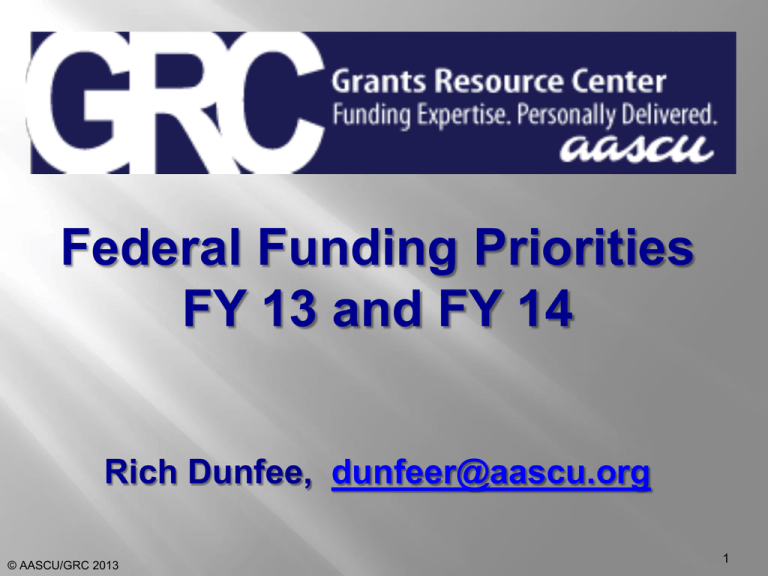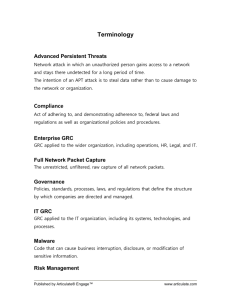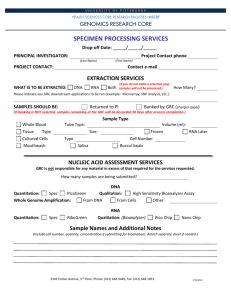Federal Funding Priorities FY 13 and FY 14 Rich Dunfee,
advertisement

Federal Funding Priorities FY 13 and FY 14 Rich Dunfee, dunfeer@aascu.org © AASCU/GRC 2013 1 President’s FY 13 budget request released 2/13: http://www.whitehouse.gov/omb/budget/Overview FY 14 administration budget not released FY 2013 Sequestration Cuts Begin on March 1, 2013 This date is a two month delay Continuing Budget Resolution(CR) is scheduled to expire on March 27, 2013. Possibility of a one year CR extension. Debt Ceiling has been raised until May 18th. In reality it wont have to be raised again until mid July National Science Foundation - $7 B (+2.5%) National Institute of Standards and Technology - $751 M (+0.1%) Note: Technology Innovation Program and Advanced Manufacturing Consortium Program funding was eliminated. Manufacturing Extension Partnership was preserved. U.S. Department of Defense Basic and Applied Research - $421 B (+6.5%) Note: Final bill also included a 10% increase for university partnerships. U.S. Department of Energy Office of Energy Efficiency and Renewable Energy - $1.05 B (+36.7%) Office of Science - $4.5 B (+4.9%) Advanced Research Projects Agency-Energy (ARPA-E) - $92 M (+53.1%) U.S. Department of Transportation - $1.1B (+6.4%) Note: Federal Transit Administration’s Research and University Research Centers budget was cut by 25%. 3 U.S. Department of Agriculture R&D - $1.9 B (-6%) Note: National Institute for Food and Agriculture and Agriculture and Food Research Initiative were spared significant cuts. National Aeronautics and Space Administration - $17.8 B (-3.5%) National Oceanic and Atmospheric Administration $620 M (-4.3%) U.S. Department of Homeland Security Research, Development, and Innovation accounts – $266M (59.7%) 4 All federal agencies, even those that received increases, are tightening their budgets. Transparency, accountability, and public access are as important for awardees as they are for agencies. Collaboration is required across agencies, sectors, institutions, and disciplines. Earmarks are out, competitiveness is in. Energy, healthcare, education, and STEM continue as the priorities. Innovation is key catch phrase. © AAASC/GRC, 2013 5 Sequestration is a fiscal policy procedure adopted by Congress to deal with the federal budget deficit. Simply put, sequestration is the cancellation of budgetary resources -- an "automatic" form of spending cutback. The Budget Control Act of 2011 set into law discretionary spending caps for ten years. (FY2012-FY2021) Reduces spending by 900 Billion over 10 years. These automatic budget cuts were triggered by the Super Committee failing to reach an agreement on spending cuts. 1.2 trillion in automatic cuts between FY 13-21; 50% from defense, 50% from nondefense Republicans are against any new revenue to prevent sequestration. Democrats are insisting on new revenue White House is insisting on 50% new revenue and 50% spending cuts. AASCU staff believes Sequestration WILL HAPPEN on March 1st. Constrained budgets mean fewer opportunities for funding In fact, there has been no reduction in the number of federal solicitations…and corporate and philanthropic increases offset federal decreases. Lower success rates reduce opportunities for first-time awardees In fact, agencies are under pressure to expand their applicant pools and their support for underrepresented groups, including minorities and early career investigators. 9 The Emphasis on Competitiveness, Job Creation, and Economic Recovery 10 Community Development Healthcare, K-12, social service Civic engagement Healthy social environments collaboration Workforce Development - Partnerships Economic Development Institutional intellectual property to the market Local entrepreneurs linking to campus facilities/people Collaboration on loan and start-up funding © AASCU/GRC 2013 11 Challenges The promotion of undergraduate research and the integration of teaching/learning/research Strategic decisions about investments The lack of good assessment models to validate our contributions © AASCU/GRC 2013 12 $7.4 B request, a 4% increase, would restore path to doubling. Excellent science isn’t enough. Opportunities will require applicants to be explicit about how research will solve national challenges. Overall funding rates may continue to decline (22% in FY 11), but only because applicant pool is growing—making room for new players. 13 $807 million would support these priority programs: Cyber-enabled Materials, Manufacturing, and Smart Systems Cyberinfrastructure Framework for 21st Century Science and Engineering Expeditions in Education Innovation Corps Integrated NSF Support Promoting Interdisciplinary Research and Education Secure and Trustworthy Cyberspace Science, Engineering, and Education for Sustainability 14 Funding for CAREER and Graduate Research Fellowships awards would increase slightly. STEM education would retain significant support. NSF and the U.S. Department of Education would provide $30 million each for a new program to improve K-16 math education and knowledge building. 15 Widening Implementation and Demonstration of Evidence-based Reforms (WIDER) program would receive $20 million. Transforming Undergraduate Education in STEM (TUES) would receive $61.5 million to improve the quality of STEM education for all undergraduate students 16 Science of Broadening Participation Sponsored by NSF Division of Behavioral and Cognitive Sciences and Division of Social and Economic Sciences (researchers submit proposals to standing programs) Cognitive, behavioral, social, and economic sciences approaches are eligible Research should identify psychological, sociological, behavioral, and economic causes and consequences of broadening participation A primary goal is to provide policymakers with evidence to foster broad participation in STEM and increase U.S. competitiveness 17 Investing in early childhood education Challenging states to adopt higher academic standards and assessments Recruiting, preparing and rewarding effective teachers Promoting excellence in schools by expanding charter schools, extending learning time and assisting lowperforming schools Increasing the number of people earning postsecondary degrees and certificates Improving the affordability and quality of postsecondary education Aligning job training programs with workforce demands © AASCU/GRC 2013 18 ED in FY 13 Total request of $69.8B, up from $68.1B Transition to Teaching and Arts in Education may be consolidated into other programs. First in the World, $55 M program to help scale up completion efforts, is the only FIPSE program slated to have a competition in FY13. © AASCU/GRC 2013 19 Illustrates the federal push toward regional collaboration through strong public-private partnerships. Offers approximately $150 million in cooperative agreements for Scale-up grants and cooperative agreements or discretionary grants for Validation grants and Development grants Allows eligible entities to: (1) expand and develop innovative practices that can serve as models of best practices, (2) work in partnership with the private sector and the philanthropic community, and (3) identify and document best practices that can be shared and taken to scale based on demonstrated success 20 Group Projects Abroad support overseas training, research, and curriculum development in modern foreign languages and area studies for groups of teachers, students, and faculty. Doctoral Dissertation Research Abroad provides grants to IHEs to award six to 12 month international research fellowships for doctoral students in modern foreign languages or area studies. Seminars Abroad—Bilateral Projects provide short-term study and travel seminars for U.S. educators in the social sciences and humanities to improve their understanding of peoples and cultures of other countries. Faculty Research Abroad Fellowships help institutions strengthen foreign language and area studies programs. Next competition expected in FY 13 21 Economic Adjustment Assistance Public Works and Economic Development Facilities University Centers Program Planning and Local Technical Assistance Small Business Development Centers 22 Sixteen federal agencies are working together on this unprecedented initiative to drive job growth through public-private partnerships in at least 20 regions around the country. High-growth clusters from rural and urban regions across the nation will compete for award funds. The Innovation Accelerator Challenge will accelerate the development of strong industry clusters - like the Research Triangle in North Carolina - that promote robust economic ecosystems and the development of a skilled workforce 23 Regional Innovation Clusters competitions in FY 10 *Clemson University, Francis Marion University, South Carolina State University, and UNC Charlotte (Carolinas Nuclear Collaborative members) *Delta State University, Jackson State University, and University of Southern Mississippi (Enterprise for Innovative Geospatial Solutions partners) *Northern Illinois University, Southern Illinois University Carbondale, and University of Illinois at Chicago (Illinois Science and Technology Coalition partners, a unit of the Illinois Smart Grid Regional Innovation Cluster) *Cleveland State University, Youngstown State University, and University of Akron (NorTech partners) *(Upper Michigan Green Aviation Coalition has 41 partners, including universities, not clear which of our members belong) 24 I6 Green - 2011 1. iGreen New England Partnership 2. Igniting Innovation (I2) Cleantech Acceleration Network (FL) 3. Proof of Concept Center for Green Chemistry Scale-up (MI) 4. Louisiana Tech Proof of Concept Center 5. Iowa Innovation Council I6 Green Project 6. Washington Clean Energy Partnership Project 25 Jobs and Innovation Accelerator Challenge 1. GreenME 2. Finger Lakes Food Processing Cluster Initiative 3. New York Renewable Energy Cluster 4. Southwestern Pennsylvania Revitalization 5. Northeast Ohio Speed-to-Market Accelerator 6. Southeast Michigan-Advanced Energy Storage Systems Initiative 7. Advanced Composites Employment Accelerator 8. Atlanta Health Information Technology Cluster 9. Space Coast Clean Energy Jobs Accelerator 10. Milwaukee Regional Water Accelerator Project 26 Jobs and Innovation Accelerator Challenge 11. Rockford Area Aerospace Cluster 12. St. Louis Bioscience Jobs and Innovation Accelerator Project 13. Minnesota's Mining Cluster 14. KC Regional Jobs Accelerator 15. The ARK: Acceleration, Resources, Knowledge 16. Center for Innovation and Enterprise Engagement 17. Upper Missouri Tribal Environmental Risk Mitigation 18. Washington Interactive Media Accelerator 19. Portland Regional Clean Tech Advance Initiative 20. San Diego-Imperial Valley Renewable Energy Generation Training/Demonstration Center 27 Coordinated by SBA; authorized through 2017 3 phase programs geared toward commercialization Small Business Innovation Research Only small businesses can apply but universities can partner 12 participating agencies 2.5% of the agency R&D budget; increasing through 2017 Small Business Technology Transfer Small business must formally collaborate with research institutions 5 participating agencies: DOD, DOE, HHS, NASA, NSF 0.3% of the agency R&D budget; increasing through 2017 28 Industry Commitment to R&D $398B 29 30 31 U.S. Department of Defense Multidisciplinary University Research Initiative (MURI) Supports multidisciplinary team research at U.S. academic institutions. Focus on basic science and engineering research of critical importance to national defense. Awards to Stimulate and Support Undergraduate Research Experiences (ASSURE) Supports undergraduate research in DoD-relevant disciplines to increase the number of high-quality undergrad science and engineering majors who ultimately decide to pursue advanced degrees © AASCU/GRC 2013 32 Opportunities Higher Education Challenge Grant Program Encourages innovative teaching enhancement projects with the potential for regional or national impact to serve as models for other institutions in the areas of food and agricultural sciences Federal-State Marketing Improvement Program (FSMIP) Funds a wide range of applied research projects that address barriers, challenges, and opportunities in marketing, transportation, and distribution of U.S. food and agricultural products domestically and internationally. © AAASC/GRC, 2013 33 National Aeronautics and Space Administration FY 13 Budget Research Opportunities in Aeronautics Supports various aeronautic research projects. Research Opportunities in Space and Earth Sciences (ROSES) Supports research and technology in space and earth sciences. Solicitations released year-round. Continuing commitment to global climate change research and monitoring system. © AASCU/GRC, 2013 34 $27.2B in Discretionary Funding (+3.2%) $5 billion in funding to the Office of Science. Promotes long-range R&D to keep America competitive in STEM fields 80% increase in Energy Efficiency and Renewable Energy applied research funding Doubles advanced manufacturing processes and advanced industrial materials R&D funding 35 National Institutes of Health Training fellowship stipends would increase by 2%. $80 M in new research money would be available for Alzheimer’s disease. Early career investigators and new investigators are a major priority. © AASCU/GRC 2013 36 Academic Research Enhancement Award (AREA) Grants - (R15) Designed with GRC members in mind Limited to institutions receiving less than $6M per year (over last 7 years) from NIH Small (for NIH) awards: $300,000 total for up to three years Active involvement of undergraduate (preferred) and graduate students in the proposed research is essential R15 is a research grant; applications should not focus on student training objectives Each NIH institute/center has its own AREA contact. Annual Deadlines: February 25, June 25, and October 25 © AASCU/GRC 2013 37 President’s FY 13 Request: $9.034B would mean an increase of nearly $1B since FY 10. Approximately $1.1M would support Health Center Program expansion under the Affordable Care Act . $71.3M would support health workforce activities. ($15M from the Public Health Fund). $250M would support Maternal, Infant, and Early Childhood Visiting Program 38 President’s FY 13 Request: $408.8M would be an increase of $3.7M over FY 12. Health Information Technology (HIT) Research would receive $25.6M, level funding. $6.7M would support new research grants for investigator-initiated HIT research. $12M would support Prevention and Public Health Funds. 39 President’s FY 13 Request of $16.2B would represent a small decrease. Priorities remain early childhood health and development and program integrity, quality, and accountability. $85M would support Head Start programs. 40 U.S. Department of Justice Highlights of Justice's FY 12 Budget $600 million for the Community Oriented Policing Services (COPS) to increase the number of police officers across the U.S. $55 million overall for the National Institute of Justice’s research, evaluation and demonstration programs $9.5 million for Grants to Reduce Violence Crimes Against Women on Campus FY 13 Total Request of $27.1 B, down from $27.2 No major cuts for discretionary grant programs © AASCU/GRC 2013 41 Highlights of CNS’ FY 12 Budget $400 million for the continued expansion of AmeriCorps State and National to almost 80,000 participants $70 million for the Social Innovation Fund to increase non-profits’ capacity to offer services in high-need communities FY 13 Total Request of $1.063B, up from $1.048B No cuts for AmeriCorps or Social Innovation Fund © AASCU/GRC 2013 42 Funds split between state and regional boards (40%) and the national office (60%) Program Divisions at the national level are: Literature & Arts Education, Multidisciplinary Arts, Performing Arts, Visual Arts, and Partnerships Partnerships essential. New programs like Our Town require multiple partners. Each institution may submit only one application per program New emphasis understanding the impact of the arts on community and economic development usually termed “creative placemaking” including new research opportunity into the value of the arts sector (first funded projects began May 2012) © AASCU/GRC 2013 43 National Arts and Humanities Youth Program Awards Recognizes the accomplishments of arts and humanities after-school and out-of-school programs with $10,000 awards The Big Read Partnership with Arts Midwest to restore reading to the center of American culture with awards of $2,500 to $20,000 The Arts and Human Development © AASCU/GRC 2013 A new task force of 13 federal agencies including divisions of HHS, NIH, NSF, Dept. of Ed, and IMLS designed to examine links between the arts and positive developmental, behavioral, and social outcomes No new funding opportunities released yet, stay updated through the quarterly webinars 44 Until 2008, these initiatives were rare, and even when they were promoted, were in practice meaningless. 45 The Trade Act Assistance Community College Career Training (ETA) program Jobs and Innovation Accelerator Challenge NSF & NIH Advancing Health Services through System Modeling Research 46 Established in 1994,the role of the EJ IWG is to guide, support and enhance federal environmental justice and community-based activities. Comprised of 17 federal agencies and several White House offices. Environmental Protection Agency (Chair) Department of Agriculture Department of Commerce Department of Defense Department of Education Department of Energy Department of Health and Human Services Department of Homeland Security Department of Housing and Urban Development Department of Interior Department of Justice Department of Labor Department of State Department of Transportation Department of Veteran's Affairs General Services Administration Small Business Administration White House Offices 47 Advancing Health Services through System Modeling Research – fosters new collaborations among health services researchers and industrial and systems engineers, with a specific emphasis on the supportive role of health IT by accepting and reviewing investigator-initiated proposals in this area. 48 49 There is a growing emphasis on crosscutting and interdisciplinary collaboration agency-wide. Some initiatives require partners from multiple departments and institutions. Even when not required, these collaborations can increase a proposal’s competitiveness—but only if well-coordinated Priority programs include Partnerships for Innovation: Accelerating Innovation Research (letters of intent due March 13), which supports technology translations and research alliances, and Interdisciplinary Research in Hazards and Disasters (Hazards SEES) (proposals due February 4) 50 International Office of International Science and Engineering coordinates and co-funds projects, but international partnerships are supported agency-wide. Catalyzing New International Collaborations funds planning visits to prepare for future collaborative research proposals Current discipline-specific examples include U.S.-Israel Collaboration in Computer Science (proposals due February 1) and supplements for Developing Country Collaborations in Plant Genome Research (proposals accepted at any time). Past solicitations have ranged from support for chemistry and organismal biology to neuroscience. 51 Collaborative submissions encouraged New investigator (NI): has not previously competed successfully as PD/PI for a significant NIH independent research Early Stage Investigator (ESI): is a new investigator within 10 years of completing his/her terminal research degree or is within 10 years of completing medical residency (or the equivalent) NIH has the goal of accelerating the the addition of those moving to independent scientific career. NIH will strive to support new investigators on R01 equivalent awards at success rates equivalent to that of established investigators submitting new (Type 1) R01 equivalent applications. 52 53


